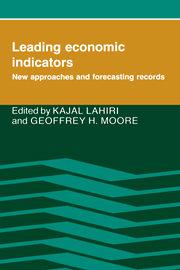Crossref Citations
This Book has been
cited by the following publications. This list is generated based on data provided by Crossref.
Zarnowitz, Victor
1992.
The Business Cycle: Theories and Evidence.
p.
3.
Dadkhah, K. M.
and
Zahedi, F.
1992.
Forecasting with leading indicators: Does the new index lead?.
Empirical Economics,
Vol. 17,
Issue. 4,
p.
485.
Dasgupta, Susmita
and
Lahiri, Kajal
1993.
On the use of dispersion measures from NAPM surveys in business cycle forecasting.
Journal of Forecasting,
Vol. 12,
Issue. 3-4,
p.
239.
Nazmi, Nader
1993.
Forecasting cyclical turning points with an index of leading indicators: A probabilistic approach.
Journal of Forecasting,
Vol. 12,
Issue. 3-4,
p.
215.
Durland, J. Michael
and
McCurdy, Thomas H.
1994.
Duration-Dependent Transitions in a Markov Model of U.S. GNP Growth.
Journal of Business & Economic Statistics,
Vol. 12,
Issue. 3,
p.
279.
Gennari, Pietro
1994.
Is the Economic Cycle Still Alive?.
p.
257.
Berk, J. M.
and
Bikker, J. A.
1995.
International interdependence of business cycles in the manufacturing industry: The use of leading indicators for forecasting and analysis.
Journal of Forecasting,
Vol. 14,
Issue. 1,
p.
1.
Emerson, Rebecca A.
and
Hendry, David F.
1996.
An evaluation of forecasting using leading indicators.
Journal of Forecasting,
Vol. 15,
Issue. 4,
p.
271.
Clements, Michael P.
and
Hendry, David F.
1996.
Time Series Models.
p.
101.
Mostaghimi, Mehdi
and
Rezayat, Fahimeh
1996.
Probability forecast of downturn in U.S. economy using classical statistical decision theory.
Empirical Economics,
Vol. 21,
Issue. 2,
p.
255.
Hendry, David F.
1997.
The Econometrics of Macroeconomic Forecasting.
The Economic Journal,
Vol. 107,
Issue. 444,
p.
1330.
BODMAN, PHILIP M.
1998.
Asymmetry and Duration Dependence in Australian GDP and Unemployment.
Economic Record,
Vol. 74,
Issue. 227,
p.
399.
BINNER, J. M.
FIELDING, A.
and
MULLINEUX, A. W.
1999.
Divisia money in a composite leading indicator of inflation.
Applied Economics,
Vol. 31,
Issue. 8,
p.
1021.
Bikker, J. A.
and
Kennedy, N. O.
1999.
Composite leading indicators of underlying inflation for seven EU countries.
Journal of Forecasting,
Vol. 18,
Issue. 4,
p.
225.
Canova, Fabio
and
Ciccarelli, Matteo
2000.
Forecasting and Turning Point Predictions in a Bayesian Panel VAR Model.
SSRN Electronic Journal,
Simone, Alejandro
2001.
In Search of Coincident and Leading Indicators of Economic Activity in Argentina.
IMF Working Papers,
Vol. 01,
Issue. 30,
p.
1.
2001.
Steepness and deepness in the Australian macroeconomy.
Applied Economics,
Vol. 33,
Issue. 3,
p.
375.
Andersson, E.
2002.
Monitoring cyclical processes. A non-parametric approach.
Journal of Applied Statistics,
Vol. 29,
Issue. 7,
p.
973.
Lahiri, Kajal
Stekler, H.O.
Yao, Vincent
and
Young, Peg
2003.
Monthly Output Index for the U.S. Transportation Sector.
SSRN Electronic Journal ,
Battaglia, Francesco
and
Fenga, Livio
2003.
Forecasting Composite Indicators with Anticipated Information: An Application to the Industrial Production Index.
Journal of the Royal Statistical Society Series C: Applied Statistics,
Vol. 52,
Issue. 3,
p.
279.



